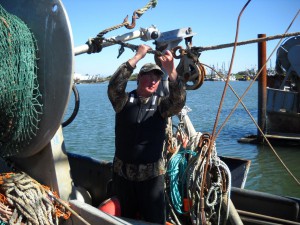Building Better Buoyancy – Developing Innovative Life Vests for Commercial Fishermen
Posted on by
Think about wearing a life jacket to work. What comes to mind? Do you think cool, comfortable, and easy-to-work in? Or, are you more inclined to think of life jackets as cumbersome, uncomfortable, and interfering? If you are leaning toward the latter, you’re right on track with what NIOSH heard from commercial fishermen back in 2008.
It is an indisputable fact: personal flotation devices (PFDs), or life jackets, save lives.1-3 However, in the commercial fishing industry where almost 90% of fatalities are caused by drowning after a fall overboard or vessel disaster, many fishermen do not routinely wear PFDs while working on deck. 4
In 2008, the NIOSH Alaska Pacific Office conducted a survey of commercial fishermen and learned a great deal about the predictors of PFD use. Fishermen who believed that PFDs interfered with their work or created an entanglement hazard were less likely to wear PFDs. NIOSH researchers concluded that fishermen may wear PFDs more often if they are familiar with newer models that have features which alleviate their concerns regarding comfort and ease of movement.5
As part of this research project, fishermen were also asked to evaluate PFDs with differing features to test for comfort, functionality, and ultimately, provide input on which type of commercially available PFD resulted in the highest worker satisfaction in actual fishing industry working conditions. Not surprisingly, NIOSH learned that fishermen had varying preferences because they work on different types of fishing vessels, using different types of gear.6 Since no federal regulations mandating the use of PFDs exist in the commercial fishing industry, NIOSH suggested that manufacturers may have more success in supplying PFDs if they engage workers in the design and promotion of newer, more comfortable PFDs.7
Based on the results of the NIOSH PFD study, a national PFD manufacturer realized there was a need for innovative PFD designs to improve comfort for workers in the fishing industry. They extended the NIOSH study, collecting additional crew member feedback on mobility of commercially available PFDs—and used the market research to develop a prototype PFD. 8 The new model was designed to be worn under bibs and raingear with 12 lbs. of flotation, the optimal amount to maintain a low profile while still maintaining buoyancy. The goal—a vest that can be worn continuously, even when going ashore, yet still have enough buoyancy to keep a fisherman who fell overboard afloat.
Now commercially available, the final PFD product (the Kent Rogue Fishing Vest*, pictured above) was awarded the 2014 Fisheries Supply Innovation Award–Safety Category at this year’s Pacific Marine Expo in Seattle, Washington.
So, what’s the moral of this story?
Asking workers what they want in protective gear is an effective way to design practical items they will be more likely to wear. What safety gear would you like to improve?
Christy Forrester, MS and Theodore D. Teske, MA
Ms. Forrester is a Health Scientist in the NIOSH Alaska Pacific Office
Mr. Teske is a Health Communication Specialist in the NIOSH Alaska Pacific Office.
*The use of trade names and commercial sources is for identification purposes only and does not imply endorsement by the National Institute for Occupational Safety and Health (NIOSH), the Centers for Disease Control and Prevention (CDC), or the U.S. Department of Health and Human Services (HHS) or imply that one product is preferred by NIOSH, CDC, or HHS over other products manufactured by other companies.
______
Visit www.cdc.gov/niosh/topics/fishing for more information about commercial fishing safety in Alaska. The data from the NIOSH study, Worker satisfaction with personal flotation devices ( PFDs ) in the fishing industry: Evaluations in actual use is available to other interested groups; please contact the NIOSH Alaska Pacific Office for more information. You can also follow the NIOSH commercial fishing safety program on Twitter: @NIOSHFishing.
References
1 Jones, C.S. [1999]. Drowning among personal watercraft passengers: the ability of personal flotation devices to preserve life on Arkansas waterways, 1994-1997. J Ark Med Soc 96, 97-98.
2 NIOSH [1993]. Preventing Drownings of Commercial Fishermen. Cincinnati, OH: U.S. Department of Health and Human Services, Centers for Disease Control and Prevention, National Institute for Occupational Safety and Health, DHHS (NIOSH) Publication No. 94-107.
3 National Transportation Safety Board [1993]. Safety Study: Recreational Boating Safety. National Transportation Safety Board, Washington, DC.
4 Lincoln, J.M., Lucas , D.L. [2010]. Occupational Fatalities in the United States Commercial Fishing Industry, 2000-2009, Journal of Agromedicine, 15:4, 343-350.
5 Lucas, D.L., Lincoln, J.M., Carozza, S.E., et al. [2013]. Predictors of personal flotation device (PFD) use among workers in the Alaska commercial fishing industry. Safety Science 53: 177–185.
6 NIOSH [2013]. PFDs That Work. Cincinnati, OH: U.S. Department of Health and Human Services, Centers for Disease Control and Prevention, National Institute for Occupational Safety and Health, DHHS (NIOSH) Publication No. 2013-131.
7 Lucas, D.L., Lincoln, J.M., Somervell, P., Teske, T. [2012] Worker satisfaction with personal flotation devices (PFDs) in the fishing industry: Evaluations in actual use. Applied Ergonomics 43: 747-752.
8 NIOSH [2014]. A Story of Impact: PFD Manufacturer Adopts NIOSH Research into Product Development Process. Cincinnati, OH: U.S. Department of Health and Human Services, Centers for Disease Control and Prevention, National Institute for Occupational Safety and Health, DHHS (NIOSH) Publication No. 2015-119.
Posted on by

